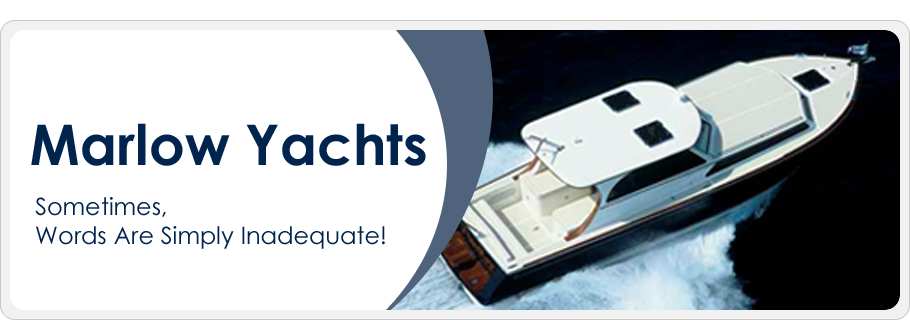| |
Marlow Prowler 375 • Classic, Open & Havana
Construction
The construction method of the Prowler Series originates with two very complex articulating major molds that make up the majority of the yacht's FRP parts. This exotic tooling allows the complete hull with its graceful tumblehome aft and built-in guard rails to emerge as a unit from the hull mold, while the elaborate superstructure mold encompasses the built-in engine boxes, built-in ventilation system, window and door recesses, cleat locations, hidden windlass and rope locker, cockpit and interior cockpit liner and numerous other features that are normally added on after the primary molding is completed due to the complexity of designing a tool that would allow removal in one component. |
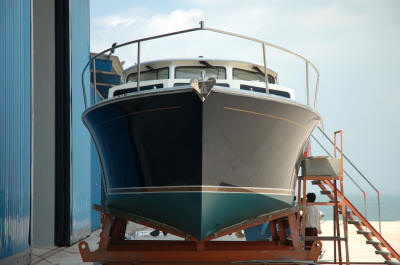 |
The contrasting non-skid colors, the texture of which mimics the tentacles on the underside of an octopus and provides sure footing, is embossed in the deck upon release from the master mold. The decision to invest in this far more costly tooling requires a degree of confidence in the ultimate success of the end product and is not for the faint of heart. Once the decision is made however, it becomes an annuity, paying the investor back handsomely each and every time a part is constructed through fewer warranty issues and a greater strength.
|
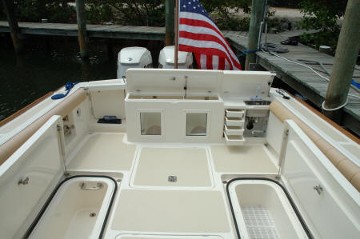 |
The interior cockpit, cowling, seating, hatches, engine boxes, etc., emerge as units from the complex superstructure mold and allow the yacht to emerge far more "complete" from the tooling after cure. By thoughtful design, this leaves only the hardtop to be mounted on the molded in FRP windshield framing producing a yacht that appears as a completed unit, yet only three parts comprise this elaborate structure. |
Resins from the Epoxy family are infused, using our proprietary Full Stack Infusion© method, into Carbon, Kevlar and specifically engineered biaxial fabrics to produce a monocoque structure free of rattles and leaks that a yacht with the speed capability of the Prowler may fall victim to as years pass. No common woven rovings to build thickness are ever considered due to their absorption of excess resin and reduced strength. The resins and their catalyzation process, which is proprietary, "bake” the infused laminate at temperatures approaching two hundred degrees Fahrenheit, while still in the master mold. This elevated temperature baking precludes post cure, often caused by subjecting dark colored hulls to extreme temperatures in the tropics. It is common for ordinary laminates to re-catalyze when subjected to temperatures greater than that which the original catalyzation process created. Without the confining structure of the master female mold, a heavily distorted hull with "print through" of the underlying reinforcements is the unavoidable result.
Since a dark blue, green or black hull in South Florida will see temperatures of 160-170 degrees F in the summer months, one must either cure the structure at temperatures beyond that which may be encountered or be willing to endure the distorted surfaces that will appear. We are not willing to accept this cosmetic flaw so often seen.
|
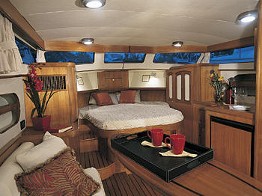 |
The beautiful interior woods and cabinetry appear to be fine furniture of solid wood when in fact they are grain-matched veneers over foam and Corecell©. The underlying structure of the lovely cabinetry is strong enough for a 250 pound human to sit upon without distortion yet weighs less than 1/2 pound per square foot. Were it to be made of common plywood, covered with wood sheathing, as is the industry standard, the weight would be more than triple that with considerably less strength. The underlying reinforcement panel resembles plastic soda straws, stacked and glued together to form honeycomb cells. These cells are cut to the thickness required and covered on all sides with lovely grain matched veneers of Andes Cherry, Burmese Teak or American Maple. The compressive strength is most impressive. |
 |
|
|
|
|
 Corner posts and door faces are selected from one original log and processed in our own mill for their unique look. Whereas the paneling that covers the honeycomb or foam bulkheads is selected for its uniformly matching grain, corner posts and other highlight area are selected purposely for their "wild" grain, adding beauty without overpowering the lovely soft hued grains of the large surfaces. These wild grains from nature are the result primarily of a period of distress in the life of the tree from which they came - perhaps a windstorm that caused a broken limb or the competition for available sunlight in the forest. Carefully selected and placed, they are as if one chose an object of art to enhance an already beautiful lady. Corner posts and door faces are selected from one original log and processed in our own mill for their unique look. Whereas the paneling that covers the honeycomb or foam bulkheads is selected for its uniformly matching grain, corner posts and other highlight area are selected purposely for their "wild" grain, adding beauty without overpowering the lovely soft hued grains of the large surfaces. These wild grains from nature are the result primarily of a period of distress in the life of the tree from which they came - perhaps a windstorm that caused a broken limb or the competition for available sunlight in the forest. Carefully selected and placed, they are as if one chose an object of art to enhance an already beautiful lady.
|
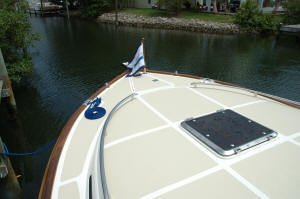 |
The seamless teak and holly sole covers a high pressure foam and fiberglass sandwich as opposed to wood, providing longevity, strength and dimensional stability that plywood cannot approach. In fact, all bulkheads and floors in the Prowler are manufactured on large tables under enormous pressure as resin is infused in precise volume, in lieu of the normal lay-up method of mops and rollers.
|
Fine English beveled mirrors grace doors and cabinets secured by Schwepper Germany door hardware as precise as a fine watch. Grohe Infinity faucets, showers and bath hardware are fitted to compliment the cabinetry throughout. Grohe warrants their Infinity line (their very best) forever, as the name implies.
From the first drop of resin to the final stainless steel trim, these yachts are created and constructed one by one, by hand, by artists and craftsmen who are working in a harmonious sequence to produce a work of art that will overwhelmingly reassure you of your choice of a Marlow Prowler.
|
|
|
|
